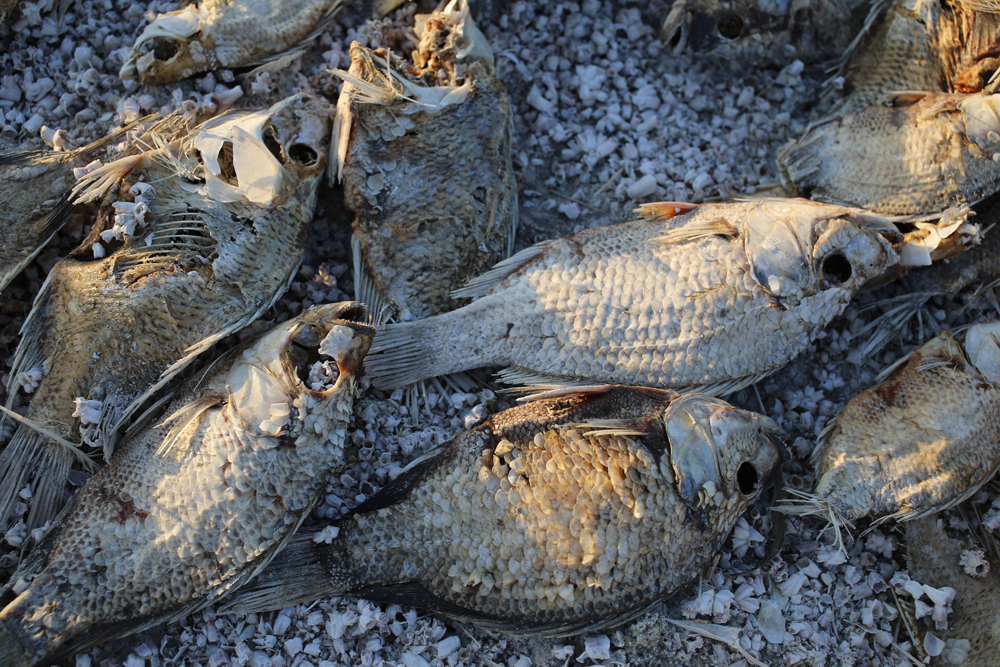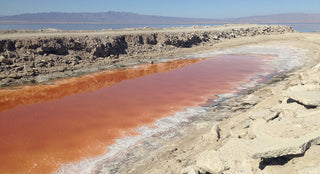Editor’s note: At press time, environmental scientists issued an air quality alert for California’s Coachella Valley after measuring record levels of hydrogen sulfide gas in the air surrounding the Salton Sea—a concentration six times more potent than levels known to be harmful to humans. The gas release from the Sea’s decomposing plant and animal matter, stirred up by high desert winds, blanketed communities as far away as Indio and Palm Springs with a noxious, sickening stench of decay and rotting eggs that lasted for more than nine continuous days.
It’s been the topic of countless editorial reports, photo journals, and even a recently-released independent film, but to truly grasp the magnitude of the ecologically disastrous, post apocalyptic pit of hell that is the Salton Sea, it’s an experience that has to be seen to be believed.

Photo: Akos Kokai via flickr
It was even more shocking and horrifying than I’d read. The relentless, 115 degree heat of the surrounding desert is instantly overpowering, disorienting, and exhausting. The haunting ruins of utter economic collapse that line the lake’s toxic shoreline serve as an immersive plot line for a nightmare.
And the inescapable reek of death that surrounds this place induces a near constant state of of dizziness, nausea, and an unexplainable paranoia. It is perhaps one of the most inhospitable landscapes of hell on Earth that exists—at least that I’ve seen—a place that could give Dante Alighieri himself a spell of bad dreams. And yet, ranking among one of the most impoverished communities in California, some 3,000 people call this place home.

Photo: Akos Kokai via flickr

Photo: Brian Parks
The story of the Salton Sea reads like the chapters of some dystopian science fiction film—adding the the eeriness of the wasteland here. A freak flood in 1904 caused the banks of the Colorado River to breach, completely flooding a massive area of the Coachella Valley desert basin. The result was the formation of a beautiful, oasis-like lake in the middle of one of the most unforgiving deserts in North America.
Throughout the first half of the last century, the accidental formation of Salton Sea was just that: an oasis. After being fed by years of uninhibited floodwater from the Colorado, it became the largest lake in California—a geographic feature that would force cartographers of the day to remap the topography of the state. The newly formed in-land sea quickly became the destination hotspot of Hollywood celebrities, real estate developers, and pleasure seekers from all over the country who flocked to its sun-soaked shores for sport fishing, water recreation, and sun soaked R&R. But it would be a short-lived honeymoon.


Environmentalists gradually began to realize that the picturesque paradise in the desert was ecologically doomed. As a virtual toxic sewage reservoir for the millions of gallons of chemical agricultural runoff from surrounding farms, and with no fresh water coming in or out, the composition of the Salton Sea slowly began reaching unstable levels of salinity, causing devastating ecosystem imbalance. Out of control algae blooms sucked vital oxygen from the waters, resulting in holocaustic levels of fish dying off. Combined was the gradual evaporation and subsequent receding of the lake itself, which made any prospect of shoreline development nearly impossible. Today, the remnants of the Sea’s golden era bake in the desert sun like the millions of suffocated fish carcasses that continuously rot along its shores, giving this place an overpowering and constant aroma of decay.
The Sea’s once thriving seaside community of Bombay Beach now sits like a partially inhabited, post-war ghost town—the blackened bones of incinerated buildings sit crumbling, unattended while drywall slabs from demolished homes serve as billboards for crudely-scrawled graffiti messages like “abandon all hope,” “leave now,” and “turn off the sun,” serving as ominous reminders of the perpetual misery here. Even occasional residents will make themselves visible, peeking out of dilapidated trailers or walking down the village’s sand and garbage-lined streets like lone survivors from some vast human extinction.


Photo: shastared via flickr
There’s a creepy sense of frenzied abandonment too, a visceral premonition that the people who were once here left in a hurry as if they somehow knew that doom was on the way. Unopened canned goods still line the cupboards of bombed out houses, children’s clothes hang in the closets of half burned homes, and random pairs of dry-rotted fishing boots sit, still together, along the shore as if the fisherman that once wore them had just left them behind.
The future of the Salton Sea looks to be even bleaker than its present state. A water transfer deal with San Diego is set to go into effect over the next two years will reportedly shut off the water flow from the Colorado river that presently irrigates all the agricultural fields that surround the lake. Aside from the economic impact, the water diversion will likely have on the already suffering community here, experts say the lack of run off water into the Salton Sea will cause it to rapidly dry up. The same experts say the exposed lake bed consisting of fine, silted sediment will create a massive dustbowl that could carry huge clouds of toxic, chemical-laiden dust clouds directly into neighboring communities like Palm Springs—serving as a final, caustic sign off for this most peculiar of ecological oddities.
***

